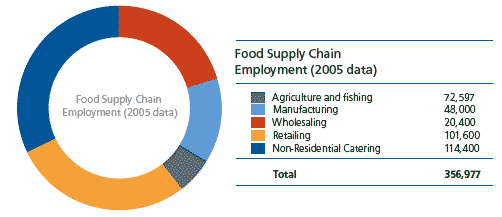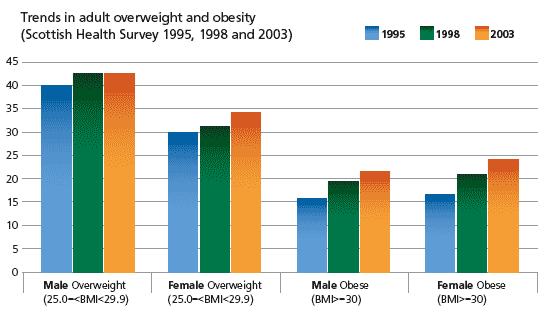Choosing the Right Ingredients: The Future for Food in Scotland: Discussion Paper
Have your say on the future for food in Scotland
Where we are now
Food and drink generates sales of £7.3bn from processing, including whisky, £1.75bn from agriculture and £0.3bn each from fish-catching and fish-farming. Food and beverages are also the top exporting industry for Scotland, with sales of £3.6bn outside the UK. Sales to the rest of the UK amount to £2.8bn. Fish and shellfish exports make up the largest proportion of total food exports.
One in five people in Scottish manufacturing work in food and drink. Food and drink businesses in Scotland come in all shapes and sizes, though many are interconnected through their respective roles in the supply chain as food processors, wholesalers, retailers or food service providers. Between them they employ over 355,000 people. Although most food and drink firms have fewer than 10 employees, three out of four people in Scotland's food and drink industry work for large or very large businesses.
There's no doubt that food and drink makes an important contribution to Scotland's economy as an employer and as a generator of wealth and profits.

Who we sell to
Different products have different markets. Scottish agriculture supplies a quarter of all the Scottish food and drink industry's raw materials. Together with the fisheries sector, it's a major supplier of raw materials to the food and drink industry UK-wide. Today the UK food and foodservice businesses together are worth a massive £157bn.
More than a quarter of Scotland's manufacturing exports are in food and drink. Our most important overseas markets are France, Spain and Italy, followed by Germany, Ireland and the USA. Some products such as whisky and premium fresh fish are highly successful as exports. Others, such as red meat, where export markets have only recently opened up after the BSE ban, are now starting to pick up again.
The public sector is a market for food in Scotland, worth around £85m. Local authorities alone account for £57m of this. A market this big can be very influential when it comes to encouraging businesses to produce, and consumers to buy, more environmentally-friendly, healthy and local foods.
The Scottish tourism industry is also a huge market for food and drink with overall spending by tourists in the region of £700m each year. It therefore plays a vital role in supporting local suppliers, growing the local economy and helping to sustain communities - and must continue to improve the quality of the food served to our visitors, to encourage them to keep returning to Scotland.
Where we buy our food
In Scotland we buy nearly all of our food from supermarkets or one of Scotland's 5000 independent convenience stores. Speciality shops and farmers' markets are becoming more popular for some sections of the community. Retailers are by far the biggest customers for Scottish produce, and partnerships with them are extremely important to many businesses in the food supply chain. They're becoming much more active in promoting local and Scottish produce, as well as highlighting healthy-eating and environmentally-friendly options.
How we eat
We often choose food according to price. For people on low incomes this tends to mean limited choice and selection of certain types of food. The other deciding factor is convenience. In 1980, we spent an average of 60 minutes a day preparing food in Scotland. In 2007 the average was 18 minutes. Again, this has a direct bearing on the kind of food we choose to purchase, prepare and eat.
Increasingly, we're more aware of the importance of healthy eating and we look for a healthier choice of foods. Sales of fruit, vegetables and fish (including oily fish) are on the increase, farmers are producing leaner meat, and other processors are responding by reducing salt, sugar and saturated fats in their foods.
The nation's health is improving, but not fast enough and there's still a lot of inequality. We eat far too much high fat and sugary food, and drink too many sugary drinks, all of which is helping to make us obese. The quantity of vegetables, potatoes, meat and meat products purchased for consumption outside the home is lower in Scotland compared to households in the rest of the UK.
Our poor diet contributes to high obesity levels and is a cause of major chronic diseases, costing the NHS hundreds of millions of pounds every year. Poor health means a poor quality of life for individuals, lost productivity for employers and distress for families caring for chronically sick relatives. Most importantly, a poor diet can shorten life expectancy.
Today we spend more money eating out than in. We choose where to eat out for reasons of convenience and location, food quality, nutritional content, value for money and to celebrate "special occasions". Restaurants, canteens, takeaways and other food outlets have more influence on what we eat than ever before, and they're starting to give us more of the information we want about the food they serve. And we can use public institutions such as nurseries, schools, hospitals and prisons to help put public policy into practice through their kitchens and canteens.
Our food choices also have an impact on the environment. A little under 20% of our ecological footprint - a measure of global environmental impact - comes from food and drink. Around a third of the food we buy is thrown into the bin and at least half of this could have been eaten. We drive our cars to the shops when we could walk or take public transport. For the first time, our generation has the opportunity to buy exotic foods and a wide range of seasonal goods all year round. This benefit can come with an environmental consequence.

What we choose
We are becoming choosier about the food we buy; the organic market in Scotland has grown from around £44m to around £66m in the last two years. Four out of five Scottish households have bought organic food at least once in the past year. Fair Trade groceries have grown by a quarter in the last year alone and are now worth around £90m a year in the UK. Fruit represents nearly half of that.
We're also becoming more interested in where our food comes from, seasonality and also whether our food is healthy. Half of us in Scotland say that we would now choose locally grown products if we could, and supermarkets are now labelling the origin and highlighting the nutritional content of some of their products.
But it's not enough for such food simply to be on the shelves. We need to know it's there, be able to get to it, afford it and know what to do with it once we've got it. So affluence, affordable transport, location, food knowledge and cooking skills all come into play. Not everyone has all, or even any, of these advantages. Big disparities still exist.
There is a problem
Thanks for your feedback